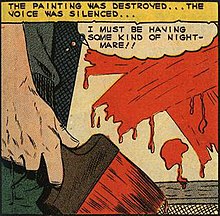브러시스트로크
Brushstrokes| 브러시스트로크 | |
|---|---|
 | |
| 아티스트 | 로이 리히텐슈타인 |
| 연도 | 1965 |
| 중간 | 캔버스에 기름과 마그나 |
| 움직임 | 팝 아트 |
| 치수 | 122.5cm × 122.5cm (48.25인치 × 48.25인치) |
| 위치 | 개인수거 |
붓스트로크스는 1965년 로이 리히텐슈타인이 그린 캔버스 팝 아트 그림의 석유와 마그나다.여러 점의 그림과 조각이 포함된 붓스트로크 시리즈의 첫 번째 요소다.그의 모든 붓스트로크 작품들과 마찬가지로, 그것은 부분적으로는 추상적 표현주의의 몸짓 그림에 대한 풍자적인 반응이다.
배경
리히텐슈타인은 첫 붓스트로크 작품을 제작하기 전 "추상적 표현주의에 대해 뭔가 할 생각을 하고 있다...문제는 붓글씨, 붓글씨 그림...일부러 물감을 떨어뜨린 것들과, 알다시피, 실제로 물방울은 상업 예술가가 그린 물방울처럼 보이는 물방울을 그린다."[1]
추상적 표현주의를 패러디하려는 초기의 목적에도 불구하고, 첫 번째 붓놀림 작품의 출처는 만화였다.[2]122.5 cm × 122.5 cm (× 48.25 in × 48.25 in)의 크기인 붓스트로크스는 붓스트로크 시리즈의 첫 번째 요소였다.[3]붓스트로크 시리즈 전편의 출처는 딕 지오다노가 쓴 찰턴 코믹스의 이상한 서스펜스 스토리 72편 (1964년 10월)이었다.[4][5]리히텐슈타인 재단에 따르면, 이 그림인 붓스트로크 외에도 같은 이름의 조각과 스크린프린트도 있다고 한다.[6][7]또한 "Brushstrokes 1970"[8]도 있다.리히텐슈타인 재단의 웹사이트는 또한 그가 1965년 가을부터 붓로크 그림을 만들기 시작했으며 11월 20일부터 12월 11일까지 카스텔리의 갤러리에서 붓로크 시리즈를 선보였다고 기록하고 있다.[9]
디테일
많은 만화를 원작으로 한 작품들과 마찬가지로 출처와의 연관성은 붓스트로크스에서 뚜렷이 드러난다.이 작품은 원본 이미지의 잘린 파생을 묘사하고 있다.[10]브러시스트로케스에서는 출처와 마찬가지로 왼손 하단에 집화가의 화필을 손에 들고, 오른쪽 상단에는 화필과 물감 튀김이 몇 번 나타난다.리히텐슈타인은 "... 붓을 잡고 있는 손의 요약 렌더링과 만화가가 페인트를 가리킨 방식을 좋아했기 때문에 이 소스를 선택했다"[2]고 말했다.오른쪽 상단의 세 획은 우세한 이미지로, 캔버스 가장자리로 제한된 왼쪽 하단의 손 부분만 보면 붓에서 페인트가 뚝뚝 떨어지는 것이 보인다.[10]이는 리히텐슈타인이 예술과 세계의 차이에 의존하는 패러디를 통해 신문에 난잡할 만한 주제를 유머러스하게 제시한 사례다.[11]
참고 항목
메모들
- ^ Hatch. p. 57.
When Lichtenstein took up the brushstroke motif in 1965, the gesture was immediately received as a satirical send-up of Abstract Expressionism. The artist himself helped pave the way for this reception. Speaking in a 1964 interview, before he had taken up the theme, he said:...
{{cite book}}:누락 또는 비어 있음title=(도움말) - ^ a b Waldman, Diane (1993). "Brushstrokes, 1965–66". Roy Lichtenstein. Solomon R. Guggenheim Museum. p. 151. ISBN 0-89207-108-7.
Although there is a real connection between the Brushstrokes painting and Abstract Expressionism, the initial source for the series was a panel from the comic strip "The Painting" (fig. 127), in Charlton Comics' Strange Suspense Stories, no. 72 (October 1964). Brushstrokes (fig. 126), 1965, is a direct reprise of that panel. In this painting, a hand holding a brush is situated at the lower-left corner of the canvas while above it to the right are a few bold horizontal and vertical strokes of paint and scattered drips. Lichtenstein liked the summary rendering of the hand holding the brush and the way in which the cartoonist indicated paint. From this image he developed a series of works that explored various aspects of painting,...
- ^ Hatch, Kevin (2007). Pop Art: Contemporary Perspectives. Yale University Press. p. 57. ISBN 978-0-300-12212-1.
- ^ Foster, Hal (2010). Francis, Mark (ed.). Pop. Phaidon. p. 150. ISBN 978-0-7148-5663-6.
Begun in the autumn of 1965, Lichtenstein's series of Brushstroke paintings was initiated after he saw a cartoon in Charlton Comics' Strange Suspense Stories. 72 (October 1964). One scene shows an exhausted yet relieved artist who has just completed a painting. This depicts two massive brushstrokes that take up the entire surface area. The absurdity of using a small paintbrush to create an image of two monumental brushstrokes was explored in many different variations. Transforming an expressive act that was mythologized for its immediacy and primal origins into a cartoon-like, mechanically produced-looking image, Lichtenstein created a reflexive commentary on gestural painting.
- ^ "Strange Suspense Stories #72". Lichtenstein Foundation. Retrieved May 25, 2012.
- ^ "Brushstrokes". Lichtenstein Foundation. Retrieved May 28, 2012.
- ^ "Brushstrokes". Lichtenstein Foundation. Retrieved May 28, 2012.
- ^ "Brushstrokes, 1970". The Lichtenstein Foundation. Archived from the original on March 15, 2011. Retrieved July 4, 2012.
- ^ "Chronology". Roy Lichtenstein Foundation. Archived from the original on May 7, 2012. Retrieved May 9, 2012.
- ^ a b Rondeau, James and Sheena Wagstaff (2012). Rigas, Maia M. (ed.). Roy Lichtenstein: A Retrospective. Art Institute of Chicago. p. 50. ISBN 978-0-300-17971-2.
- ^ Rondeau, James and Sheena Wagstaff (2012). Rigas, Maia M. (ed.). Roy Lichtenstein: A Retrospective. Art Institute of Chicago. p. 75. ISBN 978-0-300-17971-2.



